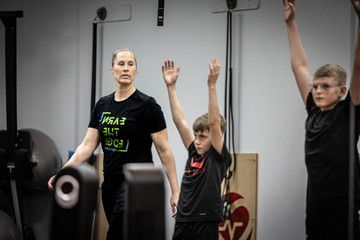🦵 Patellar Tendinopathy in Youth Athletes: What Parents Need to Know
- Laura Baden
- Aug 25
- 4 min read
If your child plays basketball, volleyball, soccer, football, or track & field, chances are they’ve complained of knee pain just below the kneecap. While it’s tempting to chalk this up to “overuse” or “growing pains,” persistent pain in this area is often a sign of patellar tendinopathy—commonly called “Jumper’s Knee.”

This condition doesn’t just cause pain—it can sideline your athlete and, if ignored, may limit performance long-term.
🚨 What is Patellar Tendinopathy?
Patellar tendinopathy is a degenerative condition of the tendon that connects the kneecap (patella) to the shinbone (tibia). It usually develops from repetitive jumping, sprinting, or high-load knee extension movements—common in youth sports.
Unlike an acute “sprain,” tendinopathy develops gradually due to imbalances, poor mechanics, or training errors.
👀 Signs & Symptoms Parents Should Watch For
Pain just below the kneecap, especially during or after jumping, sprinting, or kicking
Stiffness and soreness with activity that improves slightly after warming up but worsens post-activity
Pain when squatting, lunging, or going up/downstairs
Tenderness when pressing on the patellar tendon
Athletes describing “tightness” or a dull ache in the front of the knee
📌 Key Point: Unlike growing pains (which are more diffuse), patellar tendinopathy pain is localized to the tendon and tied to activity.
📉 Risk Factors in Youth Athletes
Research shows patellar tendinopathy is not just about “too much jumping”—it’s about how the athlete moves and absorbs force.
Risk factors include:
Poor landing mechanics (knees collapsing inward, stiff landings)
Quadriceps dominance (overusing the quads while underusing the glutes & hamstrings)
Weak hip and core control leading to poor knee alignment
Rapid increases in training load (growth spurts + heavy sports volume)
Single-sport specialization without balanced strength work
📚 Recent Evidence: A 2022 study in Frontiers in Physiology found that neuromuscular deficits—especially poor eccentric control of the quadriceps and hip weakness—are strongly linked to patellar tendon overload in youth jumping athletes.
🔍 Why Evaluation by a Professional Matters
Many athletes and parents try to “rest it out.” Unfortunately, patellar tendinopathy is not a condition that heals with rest alone. In fact, rest without proper retraining often leads to symptoms returning as soon as activity ramps back up.

That’s why professional evaluation is critical:
Movement screening identifies imbalances and faulty mechanics
Strength testing pinpoints deficits in glutes, hamstrings, and core
Load assessment ensures training and sport demands match the athlete’s current capacity
At Earn the Edge Performance, we combine sports medicine expertise with performance training to treat the root cause, not just the symptoms.
🛠️ Returning Safely: What the Process Looks Like
Recovery from patellar tendinopathy is not about “quick fixes”—it’s about progressive, smart loading and retraining movement quality.

Typical return-to-sport approach includes:
Load Management
Modifying training (reducing jump volume, adjusting practice intensity) while keeping the athlete active when possible.
Eccentric & Isometric Loading
Research shows slow, controlled eccentric squats (especially decline squats) and isometric holds reduce pain and stimulate tendon healing.
A 2021 systematic review in the British Journal of Sports Medicine confirmed progressive tendon-loading programs are more effective than passive rest or modalities.
Corrective Exercise
Glute and hamstring strengthening to balance the knee joint
Core stability to reduce compensations
Landing, cutting, and deceleration drills to fix faulty mechanics
Gradual Return-to-Sport
Once strength, mechanics, and tendon capacity improve, athletes are progressed back into higher jump and sprint loads.
🧠 Prognosis
The good news: with proper intervention, most youth athletes recover fully and return to sport stronger. The challenge is that without early recognition and correction, tendinopathy can become chronic—sometimes lasting months or years.
Early evaluation and proactive training are the keys to quick recovery.
📢 The Earn the Edge Difference

At Earn the Edge Performance, we’re not just trainers—we’re sports medicine professionals trusted by Pittsburgh’s top sports physicians, including those caring for the Penguins and Steelers.
That means your athlete gets:
A professional evaluation of their risk factors
Corrective and preventative programming tailored to them
A team that understands when to adjust training and when referral is necessary
We don’t just treat symptoms—we build resilient athletes who can jump higher, run faster, and stay healthier for longer.
✅ Take Action
If your athlete has been:
Complaining of knee pain below the kneecap
Playing high-jump volume sports like basketball, volleyball, or soccer
Going through a rapid growth spurt with heavy training load
👉 Now is the time to act—before it becomes a season-long issue.
📩 Subscribe to the Earn the Edge Academy Notifications for:
Early access to our upcoming ACL Risk Screening & Prevention Event
Injury prevention tips for parents
Evidence-based resources to keep your athlete healthy and confident
Final Word
Patellar tendinopathy isn’t just a knee issue—it’s a movement issue. With early evaluation, proper training, and smart progression, we can not only resolve pain but help athletes build bulletproof knees for the long run.
At Earn the Edge Performance, we don’t just get athletes back in the game—we teach them how to stay there.



Comments